Expert Tested: The Best Stability Running Shoes for Women
Dotdash Meredith and Yahoo Inc. may earn commission or revenue on some items through the links below.
Brooks Adrenaline GTS 21 Running Shoes support and stabilize your feet
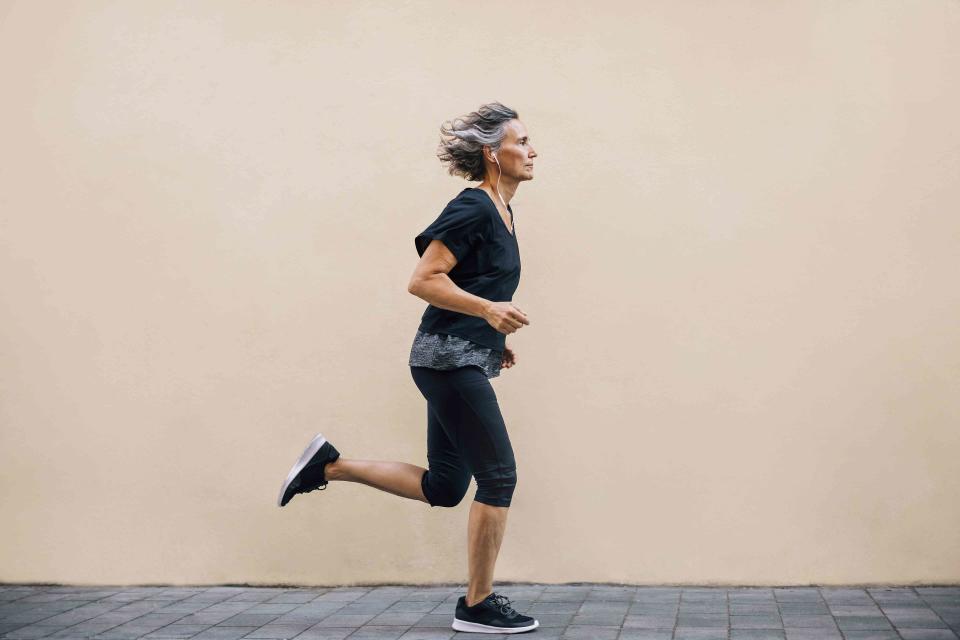
Fact checked by Marley HallReviewed by John Honerkamp
The right running shoe can mean the difference between reaching that much sought-after runner’s high and finding yourself turning back early. Stability shoes are essential for many runners who overpronate (when the foot rolls inward as you run or walk). These shoes provide additional support for the foot and ultimately reduce the risk of injury.
Stability shoes help “distribute the impact of your run and encourage a smoother heel-to-toe transition and guard against extra motion that may cause injury,” says Stefanie O’Shea, RRCA, certified level 1 run coach at Reclamation Coaching.
When choosing the best stability running shoes, find one with a supportive sole. We tested and reviewed stability running shoes out on runs and evaluated them for fit, comfort, price, materials, and durability. We are continuously testing the most popular walking and running shoes on the market to ensure we are always recommending the best stability running shoes for women.
Best Overall: Brooks Women's Adrenaline GTS 21 Running Shoes
A true stability shoe, it doesn’t feel heavy or stiff like some of its competitors, and holds up for both long runs and speedwork.
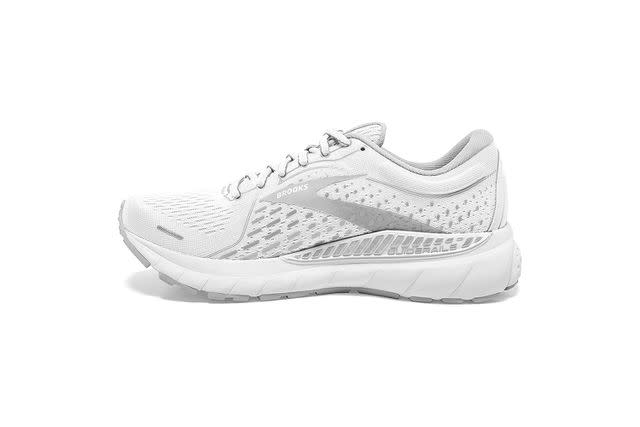
Pros
Responsive and flexible
Versatile for all types of running
Durable
Cons
Narrow toe box
We tested the GTS 21 and chose it as our best overall choice because this shoe came out on top for nearly all categories. It’s considered a stability shoe but doesn’t feel heavy or stiff like some of its competitors, and holds up for both long runs and speedwork. Our feet never felt tired or sore after any of the test runs, and while the toe box may be a little narrow for some, we found it hugged our feet without feeling too tight. This is a great shoe that provides stability without feeling heavy. It’s flexible and responsive, which is unusual for a stability shoe.
The DNA soft cushion is paired with Brooks’ signature GuideRails technology to provide support and stability to your feet, but it’s still soft and comfortable. The Adrenaline scored either a perfect or nearly perfect score for all categories, and we gave it a perfect score for overall value since it really is the whole package for a stability shoe—and definitely worth its price tag. It comes in over 25 different styles and colors and in narrow, wide, and extra-wide widths.
Price at time of publication: $91
Key Specs:
Materials: Synthetic and mesh upper, rubber sole | Cushioning: DNA loft | Weight: 9.1 ounces | Closure: Lace-up
Best Budget: Brooks Launch 8 Running Shoes
Great for runners looking for a little support while still prioritizing responsiveness and speed (and affordability).
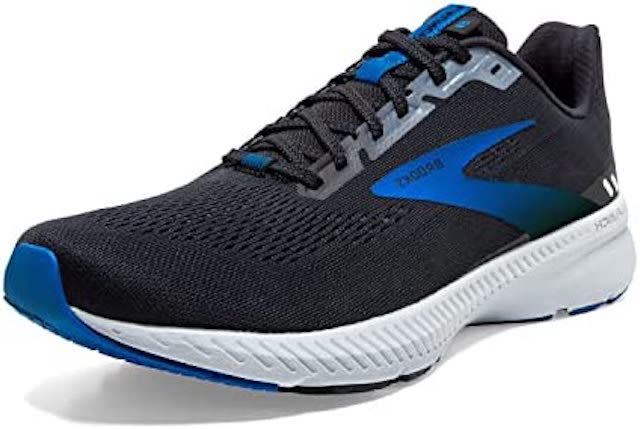
Pros
Lightweight
Firm, yet responsive
Roomy toe box
Cons
Less supportive than some stability shoes
The Brooks Launch GTS 8 brings you the comfort and technology of Brooks shoes at a more budget-friendly price point (in relative running shoe terms). During our test runs we found them light and comfortable (so we gave them a perfect score for comfort and fit). Despite their lightweight feel, the shoes still provide some support, thanks to the signature Brooks GuideRails system.
The lighter, almost neutral design makes them a great option for speedwork, but because they aren’t as supportive as some stability shoes, they may not work as well for longer runs, which is why we gave them a lower score for stability.
These shoes provide less stability than some other shoes out there, but they’re still good, stable shoes for the price. They feel more neutral than some other stability shoes but still, provide good support. Overall we found them to be a solid, comfortable shoe that would be great for someone who needs a little support but prioritizes responsiveness and speed (and affordability) in a shoe.
Price at time of publication: $100
Key Specs:
Material: Mesh upper, foam midsole | Cushioning: BioMoGo DNA | Weight: 8.1 ounces | Closure: Lace-up
Best for Road Running: Nike React Infinity Run Flyknit 2 Running Shoes
They are soft, comfortable, and offer a snug, supportive fit for a nice stable ride without extra weight.
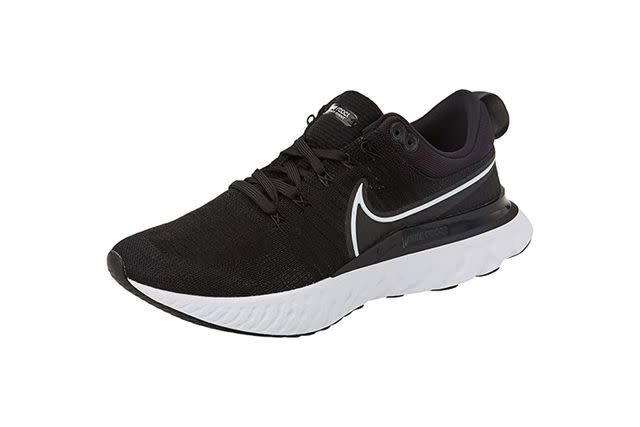
Pros
Soft ride
Firm, yet responsive
Attractive design
Cons
Very high arch support (not great for all runners)
Narrow, snug fit
Expensive
The Nike React Infinity Run Flyknit 2 brings Nike’s stylish design with functional support to your feet. When testing these, they felt springy and responsive, giving a little bounce to our stride. They are soft, comfortable, and offer a snug, supportive fit.
For someone with higher arches, this is a great shoe. But otherwise, it may feel a little uncomfortable. We like the shoes’ design and how lightweight they felt on our runs. They do have very high arch support, which did lead to a little rubbing (and concern for blisters), which is why these shoes lost points in the blister protection category. But on the right person’s feet, they can offer a nice stable ride without extra weight.
Price at time of publication: $160
Key Specs:
Material: Flywire technology upper, foam midsole | Cushioning: Foam | Weight: 8.7 ounces | Closure: Lace-up
Related:Finding the Motivation to Exercise
Best for Treadmill Running: Asics Women's Gel-Kayano 28
If you want a shoe with strong shock absorption and a comfortable cushion that is still flexible, the Gel-Kayano 28 is a good bet.
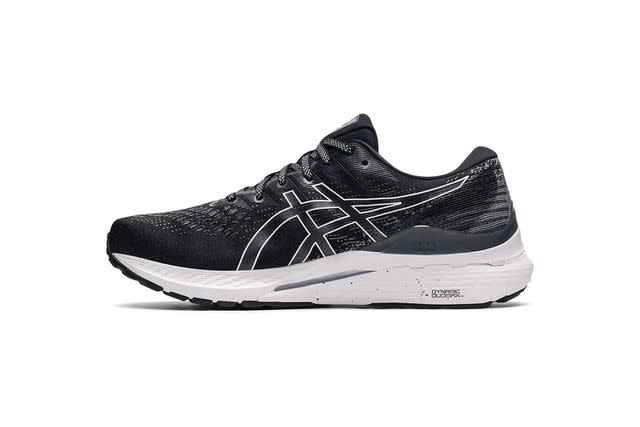
Pros
Good cushioning
Good shock absorption
Responsive and flexible
Cons
Expensive
This is Asics’ 28th version of the Gel-Kayano—a tried and true stability shoe that has withstood the test of time. For those looking for a shoe with strong shock absorption (which is key when logging miles on a treadmill) and a comfortable cushion that is still flexible, we recommend the Gel-Kayano 28.
The double cushioning system (Forefoot GEL Technology in the heel plus FF Blast Cushioning in the mid-sole) creates a comfortable ride and offers the stability many runners with overpronation are looking for. The shoe comes in 13 colors and styles and is available in narrow, medium, and wide widths.
Price at time of publication: $160
Key Specs:
Material: Mesh upper, rubber sole | Cushioning: Forefoot GEL Technology (heel) and FF Blast Cushioning (mid-sole) | Weight: 9.1 ounces | Closure: Lace-up
Related:The 12 Best Treadmill Accessories of 2023
Best for Trail Running: Altra Women’s Olympus 4
Keeps you stable on uneven surfaces while the cushioning balances your stride to reduce pain and injury.
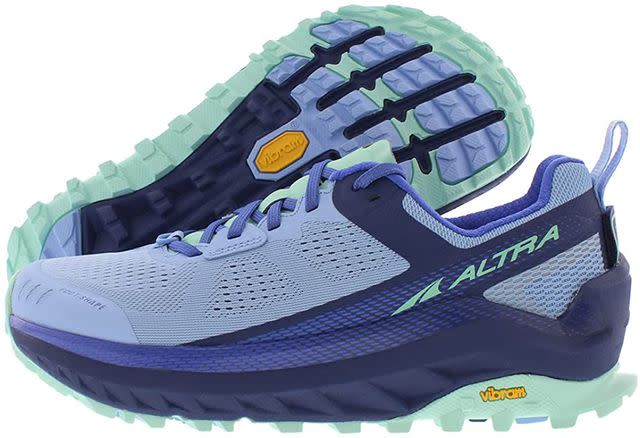
Pros
Good for both wet and dry conditions
Handles varying surfaces
Breathable
Cons
Expensive
Bulky
When you’re hitting the trails, a stable shoe with good ground grip is essential—and that’s why we recommend the Altra Olympus 4 for trail running. While it’s a bit bulky at first glance (some have likened it to the shoe version of a monster truck), it’s actually quite responsive and comfortable underfoot.
The Vibram Megagrip outsole keeps you stable on uneven surfaces while the Balanced Cushioning balances your stride to reduce pain and injury, especially in runners who overpronate.
As with other Altra shoes, the Olympus 4 features a wider toe box, giving your feet room to swell, which can happen on longer runs—especially in warmer conditions.
Price at time of publication: $170
Key Specs:
Material: Mesh upper, Compression-Molded EVA midsole, Vibram MegaGrip outsole | Cushioning: Balanced Cushioning | Weight: 9.1 ounces | Closure: Lace-up
Best Cushioned: New Balance Women's Fresh Foam 860v11
They’re supportive, yet flexible, and continued to feel comfortable after our tester wore them for several hours.
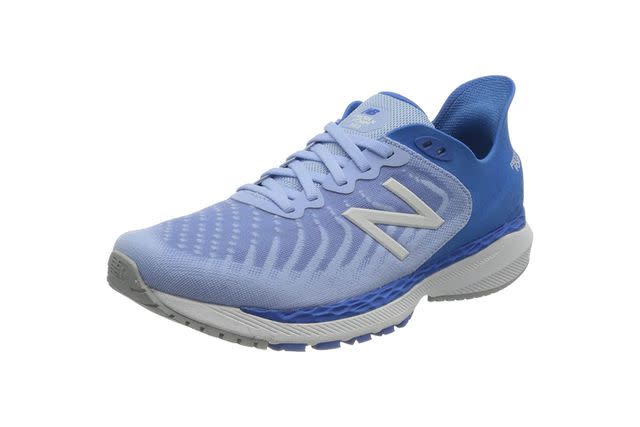
Pros
Comfortable
Good cushioning
Great fit
Cons
Less durable than other options
High heel counter may cause blisters
As soon as we laced up the New Balance Fresh Foam 850 v11s, we felt the benefit of Fresh Foam technology, which feels like you’re running (or walking) on clouds—so we gave the shoes a perfect score for cushioning. They’re supportive, yet flexible, and we continued to feel comfortable after wearing them for several hours of running and walking.
These shoes are lighter than most stability shoes, yet they still provide the support you’re looking for. The heel counter (back of the shoe) comes up very high for a running shoe, which can cause blisters if you’re not wearing a tall sock. As with many New Balance shoes, the Fresh Foam 860s do run on the narrow side, so they are good for those with narrow feet or who prefer a snug fit.
The high heel counter design is nice for extra support, but be sure to wear a slightly higher sock to avoid unwanted chafing or blisters.
Price at time of publication: $135
Key Specs:
Material: Mesh upper, rubber sole | Cushioning: Fresh Foam | Weight: 9.6 ounces | Closure: Lace-up
Best Lightweight: Hoka One One Women's Arahi 5
The low-drop and curved sole allow for a smoother transition from heel to toe, which helped our tester balance her stride on runs.
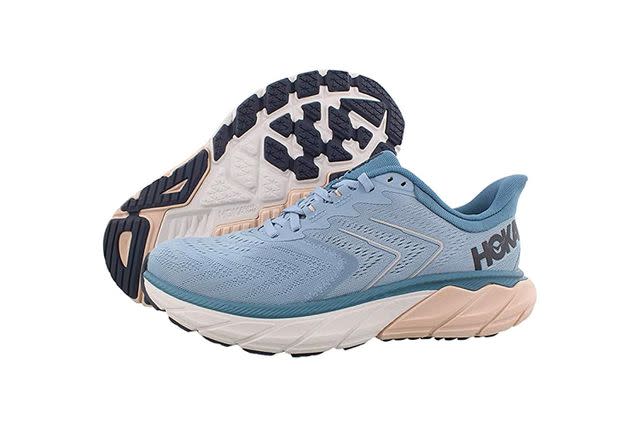
Pros
Lightweight
Good cushioning
Low heel-to-toe drop (5mm)
Cons
Stiff
Only available in two colors
At only 7.8 ounces, the Arahi was the lightest stability shoe we tested. It has a barely-there feel on your foot. During test runs, we found them comfortable for the duration and found the cushion to be very supportive. The low-drop and curved sole allow for a smoother transition from heel to toe (especially if you’re a heel striker like us), which helped us balance our strides on test runs.
These shoes have a nice design. They are firmer and less flexible than others but still provide good stability. They’re good for runners seeking a lightweight, firm running shoe. The Arahi did feel stiffer than other stability shoes we tested, but the low drop still made them feel very responsive, earning them a perfect score for the responsiveness category.
Price at time of publication: $299
Key Specs:
Material: Mesh upper, rubber outsole | Cushioning: Foam | Weight: 7.8 ounces | Closure: Lace-up
Best for Overpronators: New Balance 940 v4
They offer more support and stability than some others on the market, and the foam cushion adds comfort to your stride.
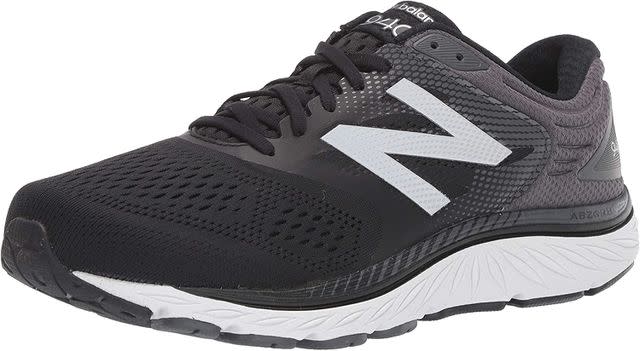
Pros
Good stability
Helps correct overpronation
Cons
Heavy
While all stability shoes can provide support for overpronators, the New Balance 940s are designed specifically for this purpose. They offer more support and stability than some others on the market, and the ABZORB foam cushioning adds comfort, especially if you’re spending hours on your feet.
The extra support does come with a little extra weight (11 ounces), which some may find slightly cumbersome. But if your main goal is to correct overpronation when you run or walk, you may be willing to sacrifice a lightweight feel.
Available in standard, narrow, wide, and extra-wide, the 940 accommodates every foot width and even leaves room for additional support, like custom inserts or orthotics, for those who need them.
Price at time of publication: $140
Key Specs:
Material: Mesh upper, ABZORB midsole | Cushioning: ABZORB foam | Weight: 11 ounces | Closure: Lace-up
Related:The 8 Best Women's Running Shoes for Underpronators
Best for Distance Running: Saucony Women's Guide 14 Running Shoe
After three runs plus many hour-long walks, our tester found them just as comfortable as the first time she put them on.
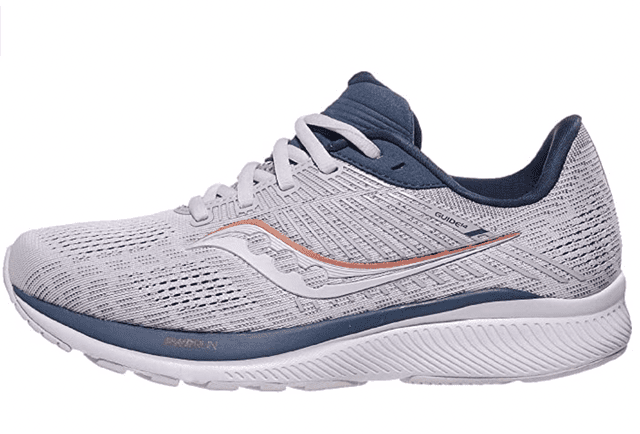
Pros
Comfortable
Responsive
Durable
Cons
Narrow toe box
The Saucony Guide 14 is a very solid stability running shoe that suits many runners’ needs. In fact, upon first testing the shoes, they reminded us a lot of the Brooks Adrenalines (our best overall pick), offering similar comfort, stability, and spring in our step.
After three runs plus many hour-long walks in these shoes, they still felt just as soft and comfortable as the first time we put them on—which is why they earned the top spot for best distance running shoes.
Although these shoes could provide a little more support in the heel and arch areas, they’re very comfortable and don’t feel heavy, even though they technically weigh more than other shoes on our list. To add to the comfort, the Guides have a soft collar that hugs your ankle and does not rub or lead to blisters, which is also very important for logging lots of miles. The shoe is available in over 10 colors and in both medium and wide widths.
Price at time of publication: $130
Key Specs:
Material: Mesh upper, rubber sole | Cushioning: PWRRUN foam | Weight: 9.4 ounces | Closure: Lace-up
Related:The 13 Best Marathon Shoes of 2023, According to a Running Coach
Best for Plantar Fasciitis: Brooks Women’s Ariel '20 Running Shoes
Provides more support than the other shoes on this list and is a favorite for those with plantar fasciitis.
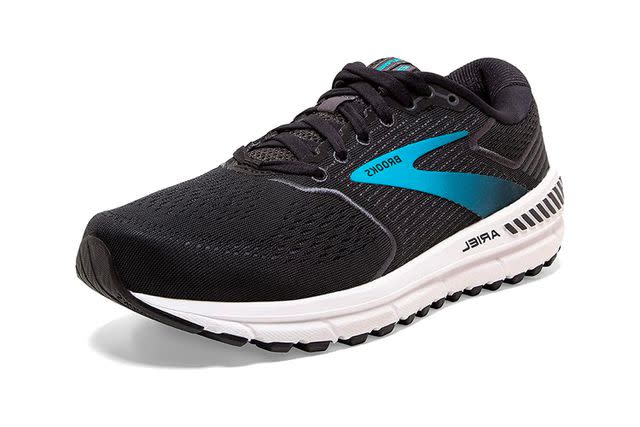
Pros
Max support
Good cushioning
Roomy toe box
Cons
Heavy
Stiff
If you’ve ever suffered from plantar fasciitis, you know that wearing a supportive shoe is key to recovery (and then future prevention). Based on our tests, we recommend the Brooks Ariel '20 for those experiencing this common condition, as it provides more support than other shoes on our list and is a favorite among those who have had or are currently dealing with plantar fasciitis.
The Ariel is made with Brooks' signature Guiderails technology, which offers support throughout the whole shoe, not just in the arch. We appreciate the additional support, even if it means a little more weight on the shoe. We believe it's a reasonable trade-off for comfort and stability during physical activity.
One advantage of these shoes is that their weight provides excellent support and stability. We feel confident that you can walk comfortably on sidewalks and park trails without worrying. While we didn't experience blisters during our time wearing them, we didn't feel completely free of chafing or rubbing. If worn for a longer period, we could see them causing discomfort or blisters with thinner socks.
Overall, we think these shoes are suitable for those with plantar fasciitis but may not be worth the higher price point for beginners or casual runners. We would recommend them to seasoned runners who prioritize stability and are willing to invest in their footwear.
Price at time of publication: $159
Key Specs:
Material: Mesh upper, BioMoGo DNA midsole | Cushion: BioMoGo DNA midsole | Weight: 10.7 ounces | Closure: Lace-up
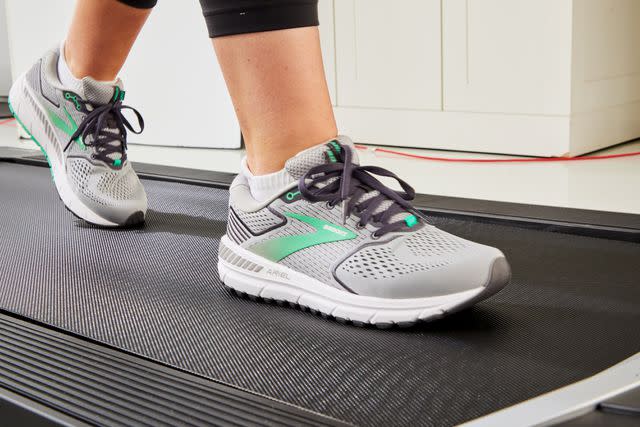
Verywell Fit / Courtesy of Tamara Staples
Related:The 7 Best Walking Shoes for Plantar Fasciitis of 2023
Best for Supination: Mizuno Women's Wave Rider 25 Running Shoe
It’s a soft, flexible shoe that helps provide a more stable platform as your foot strikes the ground.
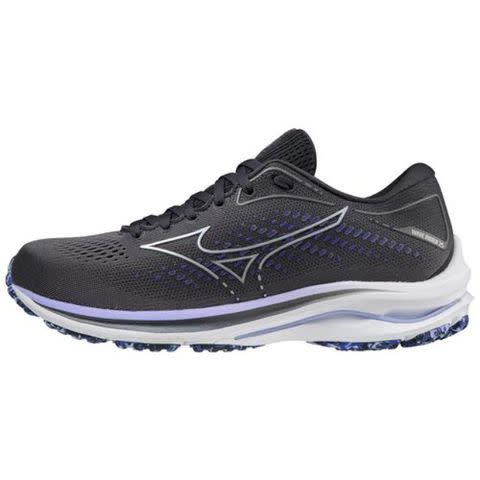
Pros
Flexible
Comfortable
Sole disperses impact
Cons
Less responsive than other options
Only one width option
Runners who supinate (or underpronate) require a more flexible neutral shoe that can also still provide some support, and that’s where the Mizuno Wave Rider 25 fits in. It’s a soft, flexible shoe that includes Mizuno’s Wave plate, which helps provide a more stable platform as your foot strikes the ground.
It does have a larger (12-millimeter) drop that, paired with the flexible forefoot, propels you forward and shifts weight to the toes, which may be helpful to some runners but problematic for others.
It’s made with eco-friendly materials and comes in a handful of colors and designs. However it’s only available in one width, so may not be appropriate for someone with narrow or very wide feet.
Price at time of publication: $140
Key Specs:
Material: Mesh upper, carbon rubber sole | Cushion: ENERZY (foam) | Weight: 8.3 ounces | Closure: Lace-up
4.8 to 5 stars: These are the best stability running shoes we tested. We recommend them without reservation.
4.5 to 4.7 stars: These stability running shoes are excellent—they might have minor flaws, but we still recommend them.
4.0 to 4.5 stars: We think these are great stability running shoes, but others are better.
3.5 to 3.9 stars: These stability running shoes are just average.
3.4 and below: We don't recommend stability running shoes with this rating; you won't find any on our list.
How We Selected and Tested
To make our best stability running shoes list, we tested six stability running shoes out on the roads (and thoroughly researched five more). We also sought expert advice from:
Stefanie O’Shea, RRCA, certified level 1 run coach at Reclamation Coaching based in Boston
Loretta Logan, DPM, MPH, associate professor and chair of the Department of Orthopedics and Pediatrics at New York College of Podiatric Medicine
We then ran 10 to 15 miles in each of the six shoes we tested and used them on easy runs, tempo runs, and long runs—totaling over 80 hours of testing over the course of three weeks.
We evaluated each shoe for cushioning, fit, responsiveness, upper comfort, lateral stability and support, and blister protection (and rated each with a score of one to five). Some shoes are more responsive and better for shorter runs or speedwork, while others provide the added support and cushioning you might need on longer runs with more time on your feet. After thoroughly evaluating each shoe for these characteristics, we also created an “overall value” score, a subjective score that weighs all of the attributes against the price of the shoe and reflects whether or not we would recommend the shoe to a friend.
What to Look for in Stability Running Shoes
Support
Stability running shoes need good support, especially in the midsole, which works to shield your body from the impact of running. Many have a medial post, which is a harder foam feature in the middle of the shoe that’s designed to counter overpronation. Some shoes may have guide rails to control side-to-side motion. Good arch support is also crucial to hold up the foot and prevent fatigue and pain that frequently accompany flat feet or low arches. Of course, you can also add insoles for flat fleet or any other specific issue, if that's your case. A deep heel cup will keep your heel in place, which “counters any inward roll,” says Dr. Logan.
Cushioning
Stability running shoes should have a well-cushioned footbed for additional support and help with shock absorption, whether you're using a balance board, a treadmill desk, or running outside, for example. The amount of cushioning you want in a shoe will depend on personal comfort, and whether you plan to use the shoes for speedwork (which typically requires less cushioning) or long runs (where you may need more cushioning).
Fit
Look for a spacious toe box so your toes can move freely. You should have at least a half-inch of space between your longest toe and the tip of your shoe. Try on shoes in the evening, as that’s the time of day when your feet are longest. Wear the same kind of socks you’ll wear when running to try on running shoes.
Frequently Asked Questions
What is a stability running shoe?
“Stability running shoes offer a modest degree of resistance to the movement known as ‘pronation,’ or rolling in of the heels during gait,” Logan says. By offsetting some of the pronation, stability shoes help reduce the risk of common problems runners face, such as plantar fasciitis, shin splints, runner’s knee, and others, she says.
Are stability shoes necessary?
Stability shoes are not for everyone. It was once thought that anyone who overpronates needs a stability shoe, but “over the last few years, podiatrists have come to realize that there are many factors that lead to injury beyond pronation,” says running coach Stefanie O’Shea.
However, “runners who develop syndromes associated with overpronation often find that they respond very favorably by switching to a stability running shoe,” Logan says. It’s also a good idea for runners who overpronate to add resistance training. Increasing muscle strength supports the foot and builds a more stable gait.
How do you know if you need a stability running shoe?
“The best way to find out is to get fitted,” O’Shea says. Many running stores have trained staff that will “look at your gait (the way you run and the way your feet land).”
Many podiatrists, running coaches, and physical therapists offer this service as well, by having you run on a treadmill or outside in different shoes and then helping you choose the best one for your foot.
Logan notes that the lack of a current problem doesn’t mean you won’t benefit from a stability shoe. “Heels that roll inward, internal knee position, and pelvic and shoulder misalignment can all be indicative of pronation,” she says, in which case you may benefit from a stability shoe.
What is the difference between a stability and a natural running shoe?
The main difference is the degree of control that a stability shoe provides. “Even ‘neutral’ shoes will offer some resistance to the pronation encountered as the foot first contacts the ground,” Logan says. “But a stability shoe contains specific features, mainly in the rear portion of the shoe, to counter this inward roll,” she adds.
Can anyone wear stability shoes?
“Anyone can wear them, but it doesn’t mean you should,” Logan says. It’s best to get fitted for a shoe that supports your particular foot and gait. You might also benefit from a stability shoe on longer runs, but not need as much support on shorter, faster runs where responsiveness and turnover are more important.
Why Trust Verywell Fit
Sarah Anzlovar is an avid runner who has been wearing stability shoes since seeing a podiatrist nearly 15 years ago for both hip and foot pain during a half marathon training cycle. She’s tried many different shoes over the years—and is always keeping up with the latest releases—but regularly comes back to her Brooks Adrenalines for their comfort and support.
Additional reporting by Christine Luff
Although her running gait doesn’t require stability running shoes, running coach Christine Luff has advised trainees who need them. She recommends getting fitted for the right running shoes and sticking to reputable brands such as Asics, Brooks, New Balance, Nike, Mizuno, Hoka, and Saucony.

